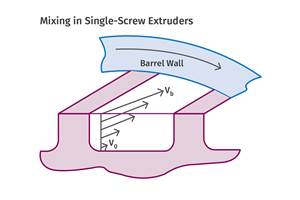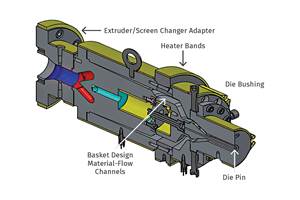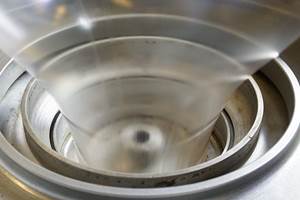Water, Oil, Air, or None?
There is no one 'best' barrel cooling medium, but there seems to be a shift in the industry toward air cooling.
What type of barrel cooling is best for your extruder? Barrel cooling effectiveness is largely related to the characteristics of the cooling medium. That is, its heat capacity and, in the case of water, its heat of vaporization. A comparison of the three cooling media and those key characteristics appears in the accompanying table.
There is no one “best” barrel cooling medium, but there seems to be a shift in the industry toward air cooling. This has been prompted by the development of highly effective air-cooling systems that are many times more effective than the old systems, where air was simply passed over conventional heaters.
Water cooling has the advantage of being able to remove an enormous amount of heat very quickly. That’s because water has a high heat capacity and changes to steam immediately upon entering the heater coils. Water has a heat capacity of 1 Btu/lb-°F, but when it flashes to steam its heat of vaporization is 1050 Btu/lb. Although very effective at removing heat, water systems can destabilize the extruder even when using the most sophisticated PID controls with process-tuning functions.
Also as a result of their superior cooling effectiveness, water systems offer the operator the ability to overcool the barrel in individual zones, which can actually disrupt the melting pattern. Overcooling negatively affects the energy efficiency of the extruder. In severe cases, 30% of the drive energy can be removed by the cooling system. Not only is this a significant loss of efficiency, but the water then requires cooling for reintroduction into the process, requiring the use of even more energy.
Oil is a less severe cooling medium than water, as most heat-transfer oils have less than half the heat capacity of water. But more importantly, these cooling oils do not vaporize at processing temperatures, which helps to eliminate instability while reducing energy losses. However oil systems are more expensive than either water or air systems and add another medium that needs monitoring and maintenance.
Air cooling is very gentle compared with water, as the heat capacity of air is about one quarter that of water. However, with modern air-cooling jacket designs, their efficiency approaches that of water cooling. Air cooling also eliminates the piping and valving needed for both water or oil systems and results in a more streamlined extruder design. Naturally leaks are eliminated as well.
The disadvantage is that the hot air exiting the heaters is discharged into the process area. This can be an advantage in cold weather but not so desirable in hot weather unless the air can be vented outside.
IT’S NOT AN OVEN
Barrel cooling in general is overused by operating people, many of whom perceive the barrel as an oven—if you set the temperature right, you won’t burn the cookies. However, extruders don’t work like that; the primary heat source is inside the barrel from mechanical working rather than outside from the heaters. By raising the barrel temperatures you tend to keep the heat in the barrel, and by lowering them you tend to remove a percentage of the internally generated heat.
Removal of heat often can be advantageous after the polymer is melted, for reducing the melt temperature. However the effect is greatly overestimated by many operators. Removal of the internally generated heat can be a disadvantage in the feeding and melting areas of the extruder, where the purpose of the extruder is to melt the polymer by generating heat through viscous dissipation or shear.
All cooling systems have their pros and cons, but using no cooling at all puts an onus on the screw design that can only be met at a very limited range of conditions. With any screw design the melt temperature will rise with increasing speed and head pressure. Also, the melting area elongates as the speed increases. This can cause operator concerns that they try to counter with barrel cooling. When used judiciously, the loss of stability and energy efficiency can be minimal with barrel cooling.
Related Content
Single vs. Twin-Screw Extruders: Why Mixing is Different
There have been many attempts to provide twin-screw-like mixing in singles, but except at very limited outputs none have been adequate. The odds of future success are long due to the inherent differences in the equipment types.
Read MoreHow to Select the Right Tooling for Pipe Extrusion
In pipe extrusion, selecting or building a complementary set of tooling often poses challenges due to a range of qualitative factors. Here’s some guidance to help you out.
Read MoreReduce Downtime and Scrap in the Blown Film Industry
The blown film sector now benefits from a tailored solution developed by Chem-Trend to preserve integrity of the bubble.
Read MoreHow Polymer Melts in Single-Screw Extruders
Understanding how polymer melts in a single-screw extruder could help you optimize your screw design to eliminate defect-causing solid polymer fragments.
Read MoreRead Next
Lead the Conversation, Change the Conversation
Coverage of single-use plastics can be both misleading and demoralizing. Here are 10 tips for changing the perception of the plastics industry at your company and in your community.
Read MoreBeyond Prototypes: 8 Ways the Plastics Industry Is Using 3D Printing
Plastics processors are finding applications for 3D printing around the plant and across the supply chain. Here are 8 examples to look for at NPE2024.
Read MoreFor PLASTICS' CEO Seaholm, NPE to Shine Light on Sustainability Successes
With advocacy, communication and sustainability as three main pillars, Seaholm leads a trade association to NPE that ‘is more active today than we have ever been.’
Read More.jpg;width=70;height=70;mode=crop)












